
Atractylis is a genus of plants in the family Asteraceae.

Anthemis is a genus of aromatic flowering plants in the family Asteraceae, closely related to Chamaemelum, and like that genus, known by the common name chamomile; some species are also called dog-fennel or mayweed. Anthemis are native to the Mediterranean region and southwest Asia east to Iran. A number of species have also become naturalized in the United Kingdom and other parts of the world.

Sonchus is a genus of flowering plants in the tribe Cichorieae within the family Asteraceae and are commonly known as sow thistles. Sowthistles are annual, biennial or perennial herbs, with or without rhizomes and a few are even woody.

Pilosella is a genus of flowering plants in the family Asteraceae. Some sources include it within the genus Hieracium.

Gnaphalium is a genus of flowering plants in the family Asteraceae, commonly called cudweeds. They are widespread and common in temperate regions, although some are found on tropical mountains or in the subtropical regions of the world.
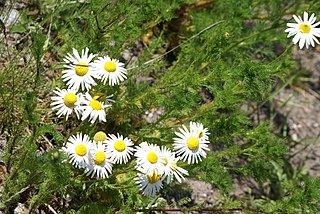
Tripleurospermum is a genus in the chamomile tribe within the sunflower family. Mayweed is a common name for plants in this genus.

The Cardueae are a tribe of flowering plants in the daisy family (Asteraceae) and the subfamily Carduoideae. Most of them are commonly known as thistles; four of the best known genera are Carduus, Cynara, Cirsium, and Onopordum.

Guizotia is a genus of African herbs in the family Asteraceae. They are often known as sunflecks. The species Guizotia abyssinica is occasionally found outside of cultivation in Europe, North America and Asia.

Pectis is a genus of flowering plants in the family Asteraceae described as a genus by Linnaeus in 1759.

Filago is a genus of plants in the sunflower family, native from Europe and northern Africa to Mongolia, Nepal, and Macaronesia. They are sometimes called cottonroses or cudweeds.

Anthemideae is a tribe of flowering plants in the family, Asteraceae, and the subfamily Asteroideae. They are distributed worldwide with concentrations in central Asia, the Mediterranean Basin, and southern Africa. Most species of plant known as chamomile belong to genera of this tribe.
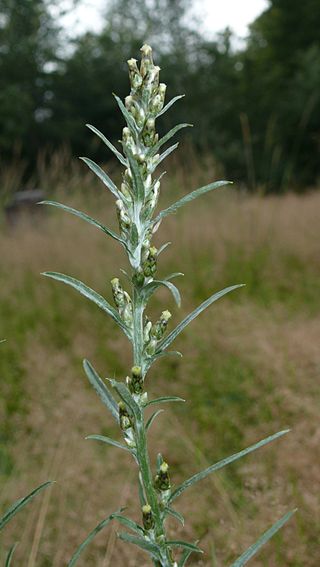
Omalotheca sylvatica, synonyms including Gnaphalium sylvaticum, is a species of plant in the family Asteraceae. It is commonly known as heath cudweed, wood cudweed, golden motherwort, chafeweed, owl's crown, and woodland arctic cudweed. It is widespread across the temperate Northern Hemisphere, throughout North America and Eurasia. The species was first formally described by Carl Linnaeus in 1753 as Gnaphalium sylvaticum.

Ifloga is a genus of flowering plants in the family Asteraceae.
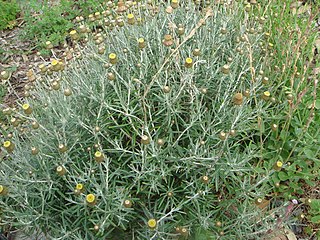
Phagnalon is a genus of flowering plants in the family Asteraceae native to Europe, Asia, and North Africa.
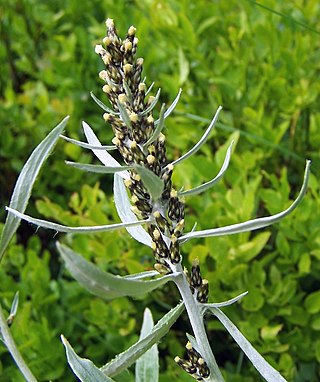
Omalotheca norvegica, synonym Gnaphalium norvegicum, is a European species of plants in the family Asteraceae. It is known as the highland cudweed or Norwegian arctic cudweed. It is native to eastern Canada and Greenland, and widespread across much of Eurasia from the Mediterranean north to Finland and Iceland and east to Siberia.
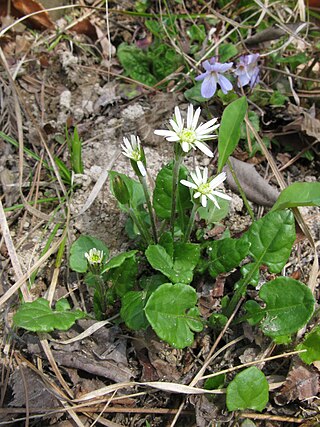
Leibnitzia (sunbonnets) is a genus of Asian and North American flowering plants in the family Asteraceae.
Chamaeleon is a genus of plants in the Asteraceae family. They are native to an area from the Western Mediterranean to Pakistan.

Cota is a genus belonging to the chamomile tribe within the sunflower family. It is native to Europe, North Africa, and southwestern Asia, with a few species naturalized elsewhere. It is an herbaceous plant with flower heads including white or yellow ray florets and yellow disc florets.

















